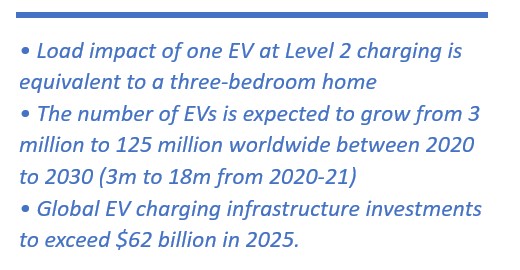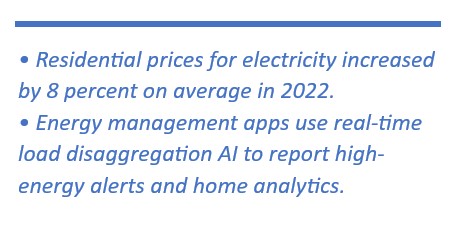The Energy Transition
What is it?
As policy makers, regulators and utilities move forward with carbon reduction goals, a transition to electrification is at the forefront. Simply put, this means the use of clean energy to power vehicles (EVs) and consumer appliances for HVAC, water heating, and cooking.
Simultaneously, utilities are in the process of retiring as much as 72 gigawatts of generation over the next eight years – roughly 10% of the United States peak demand. According to NERC, this is creating supply and demand imbalances in parts of the country, as demand for electricity accelerates while baseload capacity is being reduced. In addition to concerns about generation, the expansion of EV charging stations for homes, businesses, and fleet vehicles will require infrastructure upgrades to adequately support additional loads.
Demand for energy that exceeds supply often leads to a power outage, and when tied to an extreme weather event (such as Winter Storm Uri) can create public safety issues and adverse economic conditions that last well beyond the event.
Preemptively addressing these weaknesses in the power grid requires infrastructure upgrades and access to real-time information. National Grid is investing in smart grid technology to improve system planning, predictive analytics, and load balancing capabilities. Adding the grid edge sensing found in new smart meter platforms provides high resolution data on each circuit, which helps inform infrastructure improvements.
An Adaptive Grid

Utilities have commonly relied upon substation monitors or distribution devices downline to measure power quality, detect faults, and process information on grid conditions. But the rise of two-way power flows from distributed energy resources and significant loads appearing on a circuit overnight require grid edge data to properly monitor and react. The data available from first-generation AMI meters, while useful, presented a historical picture of what had happened on grid, but was incapable of providing real-time situational awareness or automated decision-making at the grid edge.
The Landis+Gyr Revelo electric metering platform separates traditional metrology from edge processing and grid sensing functions, providing additional security for the metering network and the headroom to continually analyze high-resolution waveform data for load disaggregation and anomaly detection.
Applied to the challenges of situational awareness and real-time intervention, waveform data that is immediately processed at the grid edge, combined with machine learning capabilities, provides tools for both the utility and the consumer to manage energy demand and/or distributed energy resource (DER) generation in a way that is verifiable and meaningful.
The key to building an adaptive grid is granular information combined with distributed intelligence on the system. On the grid side of the meter, waveform anomalies created by vegetation issues, failing transformers, switches, or insulators all present a unique waveform signature that can be used to pinpoint trouble spots before outages occur. On the consumer side, high resolution data supports automated demand management, energy efficiency, and DER optimization. Pattern detection capabilities provide power quality metrics that can be acted upon at the grid edge the moment intervention is needed.
System Integration
 The grid modernization strategy at National Grid is centered on flexibility and future preparedness.
The grid modernization strategy at National Grid is centered on flexibility and future preparedness.
The field network connects meters using Wi-SUN Alliance’s Field Area Network protocol, providing a secure IPv6 mesh covering the NG service area.
Data comes directly from specialized applications at various points from grid-edge to substation. These specialized applications (grid apps) are quite similar to mobile apps and can be developed in Java. Edge software developer kits (SDKs) enable developers to either convert existing software to an edge app hosted on the meter, or to create an app to address a specific utility need. Energy companies deploy and manage apps using an “app store” concept for vetting and approving apps before they are ported to the edge processor in the meter. App capabilities help extend the lifecycle of hardware assets by allowing them to adapt to future business cases as they arise.
National Grid’s technology integration strategy utilizes a modular platform that can be customized as needed, supported by a broad base of vendor relationships to create a “best fit” environment for applications and idea generation. Traditional interval data generated by AMI can be blended with household data and weather information, then accessed through the platform’s APIs and SDKs, allowing additional National Grid partners to enhance their end-customer experiences around solar and DER adoption, smart home technologies, marketplaces, and even not-yet-imagined vendor offerings that AI is starting to enable.
The Consumer Equation
For consumers, the energy transition feels like moving from a cellphone to a smartphone. Installing smart meters (AMI), edge intelligence, and apps for the home realizes the vision of the “smart home” giving every customer control of their energy use. This control shields the customer from the risk of soaring energy prices through demand pricing rates with affordable baseload limits.
Customers see proven savings based on timing of energy use and AMI disaggregation information. Advanced guidance will lead customers to optimal rate decisions considering different time of use (TOU) rates with forecasted energy use. Insights are delivered across multiple channels with a combination of introductory, weekly, and post-bill timing. Insights include peak period disaggregation, educating customers about peak time energy use broken out by appliance (EV charging, cooling, water heating, and dryer use), informing adjustments to reduce peak rate costs and adopt behavior changes.
National Grid is also the first utility to offer the Sense real-time energy monitoring app to all customers, with costs covered in the base customer service fee. The app monitors waveform signatures of appliances and other home loads, along with machine learning, to accurately provide immediate load disaggregation at the grid edge. This information is then made accessible on a customer’s mobile phone. Future use cases include an alert for appliances that are not running at peak efficiency (i.e. “check engine light” for your air conditioner). This data helps partners to better serve all National Grid customers, regardless of income, who might benefit from energy optimization programs or devices, reducing energy burden and enabling all to complete the energy transition regardless of their financial situation.
Bottom-line, this enables the customer to control their energy use and moves the utility into the role of energy advisor. And it’s equitable, helping all customers, especially those of highest need.
NERC raises North American power system reliability flags as demand could outstrip supply, 13 Dec 2023 [link]
National Grid, Advanced Meter Infrastructure (AMI) integrations visual example:

About Us
National Grid (NYSE: NGG) is an electricity, natural gas, and clean energy delivery company serving more than 20 million people through our networks in New York and Massachusetts. National Grid is focused on building a smarter, stronger, cleaner energy future — transforming our networks with more reliable and resilient energy solutions to meet state climate goals and reduce greenhouse gas emissions.
For more information, please visit our website, follow us on X (formerly Twitter), watch us on YouTube, like us on Facebook and find us on Instagram.
Landis+Gyr (SWX: LAND) is creating a greener tomorrow by providing flexibility management solutions from the grid edge to the control room. These provide grid edge sensing and control capabilities that support grid reliability, distributed energy resource integration and support for transportation electrification.
As partners, we empower customers and consumers to utilize resources in a more informed and sustainable way.
Together, we manage energy better.
https://www.landisgyr.com/about/
About the Authors

Brian Walsh, Director, IT Technical Product Management, AMI, National Grid
Brian Walsh serves National Grid, plc, as Director, Head of AMI IT Solution Delivery & Technical Product Management. Previously, he served as Vice President, Chief of Staff, Consumer Digital at U.S. Bank overseeing the build of best-in-class mobile banking products from 2018-2021. From 2015-2018, Brian served as IT PMO Lead, Chief of Staff to CIO, at Digital River Inc building an API shopping experience for Samsung Americas, virtualizing data centers, and optimizing recurring payments. Before this, Brian held the position of Project Manager, from 2013-2015 working at Exact Holding B.V. from 2013-2015. From 2011-2013, Brian was Head of IT & Technical Program Manager at EnergyPrint. Previously, Brian served Microsoft corporate clients as their Technical Account Manager from 2007-2011. Prior to 2007, Brian served IBM as a business transformation consultant within GBS. Brian completed master’s coursework in Leadership at Duke University, Master of Business Administration (MBA) at North Dakota State University (NDSU), and undergrad in Computer Science and Economics at the University of Jamestown (UJ)

Jeff Scheb, Director of Solutions & System Architecture, Landis+Gyr
Jeff leads the Solutions and System Architecture team at Landis+Gyr, focused on developing end-to-end technology solutions that deliver better energy management outcomes for utilities. Jeff has been with Landis+Gyr for more than 18 years, previously serving in other leadership positions including Product Management, Solution Architecture, and Research & Development. Jeff holds an M.B.A. from the Georgia Institute of Technology, where he also completed his M.S. in Electrical & Computer Engineering and B.S. in Electrical Engineering.










